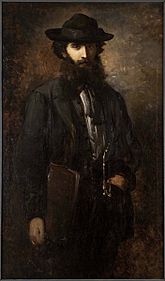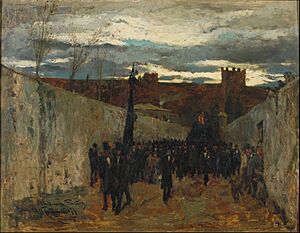Ramón Tusquets y Maignon facts for kids
Quick facts for kids
Ramón Tusquets y Maignon
|
|
|---|---|

Portrait by Ramón Martí Alsina (1867)
|
|
| Born | 1837 Barcelona, Spain
|
| Died | 11 March 1904 Rome, Italy
|
| Nationality | Spanish-Italian |
Ramón Tusquets y Maignon (born in Barcelona, Spain, in 1837 – died in Rome, Italy, on March 11, 1904) was a talented painter from both Italy and Spain. He was known for painting many different kinds of subjects. These included scenes from the Middle East (called orientalist themes), important historical events, and everyday life in the countryside of Campania, Italy.
Contents
Early Life and Art Studies
Ramón Tusquets grew up in Barcelona, Spain. His father was a rich merchant who wanted Ramón to follow in his footsteps and work in business. However, Ramón had a different dream. After his father passed away, Ramón decided to become an artist.
He started learning to paint with a local artist named Ramón Moliné. Soon after, he saved up enough money to move to Rome, Italy. There, he studied at the Chigi Academy. He also became friends with other painters from Catalonia (a region in Spain) who lived in Rome.
Connecting Spain and Italy Through Art
Even though Ramón lived in Italy, he always kept his artistic ties with Spain. In 1867, he sent a painting called El mendigo o Periódico (The Beggar or Newspaper) to a big art show in Spain. It won a third-class medal! He continued to show his art in Spain throughout the late 1800s.
For example, in 1871, he won a second-class medal for his work Le Opere, campiña romana (The Works, Roman Countryside). He also took part in important exhibitions in Barcelona in 1867 and 1886.
At the same time, his success in Spain helped him show his art in international exhibitions. He won an award at the Naples exhibition in 1877 for his painting Al toque del Ave María (At the Sound of the Ave Maria). He also showed his art at the Universal Exhibition in Vienna in 1876 and in Paris in 1878.
Artistic Influences and Style
Ramón Tusquets spent many years in Naples, Italy, where he painted using both oil and watercolor. His art was a mix of Spanish and Italian styles. In Italy, he became close friends with the Spanish painter Mariano Fortuny. Fortuny inspired him to paint scenes from the Middle East and views of Rome and its surroundings.
However, Ramón was also influenced by Italian artists like Domenico Morelli and the School of Portici group in Naples. Over time, Ramón wanted to paint bigger and more important subjects. He started creating large paintings about history and everyday life.
Important Historical Paintings
In 1886, Ramón painted five large artworks about Catalan history for the home of Miguel Boada. These paintings showed important moments like:
- The Proclamation of the Prince of Viana
- Fiveller and Ferdinand of Antequera
- The Embarcation of Jaime I to Mallorca
- Roger de Lluria and the son of the count of Anjou
- The Countess of Urgell asking for grace from the Count of Antequera
These works showed his skill in capturing historical events on a grand scale.
Later Career and Recognition
Ramón Tusquets became the President of the International Artistic Circle of Rome. This was a very important position! He was also asked to paint an official portrait of Queen Maria Cristina for the city hall of Barcelona.
Some of his later famous paintings include:
- Después del Oficio del Pontificado (After the Pontifical Office, 1888)
- Joven argelina (Algerian Youth, 1891)
- Guardia suizo del Vaticano (Swiss Guard of the Vatican)
- La fuga (The Escape)
His paintings were featured in the most popular illustrated magazines of his time. They were also shown at many international art exhibitions. The Sala Parés art gallery in Barcelona even had a special show just for his works. He often contributed to a publication called “Album Salón.”
Other works by Ramón Tusquets include La fuga interrotta (The Interrupted Escape) and La conca dell' Ave Maria (The Valley of the Ave Maria), which were shown in Naples in 1877. In 1880, he exhibited two oil paintings, Il bosco (The Forest) and La laguna (The Lagoon), and three watercolors: La befana (The Befana), Svizzero del Papa (The Pope's Swiss Guard), and Toilette (Getting Ready).
See also
 In Spanish: Ramón Tusquets para niños
In Spanish: Ramón Tusquets para niños



